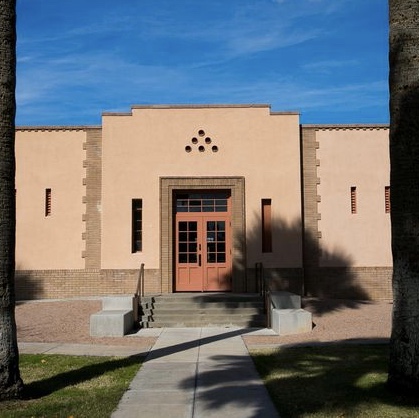(Written by JDD Specialties for Terry Benelli, executive director of LISC Phoenix.)
Eskwel uma angkyahkya LISC.
“Thank you, it’s good you all came here today to the LISC event,” White Spider Girl said in Hopi language. What followed her greeting at a March 22 gathering of LISC executive directors in downtown Phoenix was a brief, compelling account in English of the 99-year history of the Phoenix Indian School site three miles away.
At the end of the boarding school story of tragedy and triumph, White Spider Girl, also known as Patty Talahongva, community development manager at Native American Connections, smiled and said she wished she had a drum roll for the exciting news she would share publicly for the first time: City-financed construction begins immediately to restore the historic Phoenix Indian School music building. Native culture will activate the public space in the spring of 2017.
Expect drumming and so much more.
The blend of cultures and languages to discuss the Phoenix Indian School Legacy Project, which had early financial support from LISC Phoenix and the Caterpillar Foundation, is a hint of the cultural enrichment that will occur at Steele Indian School Park. Adaptive re-use plans for the building could make the project one of the region’s best examples of cultural creative placemaking.
The music building has stood quiet for 26 years. Its complicated history is a powerful refrain of the rarely told legacy of government-run boarding schools for Native American children.
For several decades, children were forcibly removed from their homes on reservations and sent to the school created by an Army officer who fought Indian wars. He believed military-style, Christian-based assimilation was a better path to deal with Native Americans. That meant stripping native peoples of all vestiges of their culture.
Phoenix Indian School was once a large complex of 27 buildings. The music building originally was an elementary school built in 1931. (Imagine that. Five-year-olds sent to boarding school hundreds of miles from home.) It is one of three historic buildings on the site that is now Steele Indian School Park near Central Avenue and Indian School Road.
Phoenix Indian School earned acclaim for its music program, especially its marching band, which performed at Arizona statehood festivities in 1912 and at the state’s anniversary celebration 50 years later.
“When they started that band at the turn of the (20th) century, these kids came to school not knowing English, not speaking each other’s languages, never seeing a trombone or a piccolo or whatever instrument they were handed, and not knowing how to read music,” said Talahongva, an alumna of Phoenix Indian School. “And yet they mastered, not only playing an instrument but reading music, and then they became one of the top bands in the whole region.”
The band, orchestra and choir rehearsed European music in the music building. When it is brought back to life in 2017, it will be a Native American cultural center — the first in a state with 22 federally recognized tribes.
The 6,000 square feet of renovated space will include a room large enough for music and dance demonstrations, a commercial kitchen for entrepreneurial and for health and nutrition instruction, and a multimedia, museum-quality gallery about Phoenix Indian School.
Diana Yazzie Devine, CEO of Native American Connections, said one of the compelling needs identified in charrettes on the Phoenix Indian School Legacy Project was to ensure the renovation reflected the boarding school experience.
“It was always about ‘We need to tell the story’, ” Devine said of discussions with alumni and tribal members. “They need to remember … what this school meant to the city of Phoenix, and for children to know why Indian School Road is called Indian School Road. It’s so important that children have a realistic understanding of what the Native American experience was in our country and in our state.”
At the LISC reception, Manuel Castro of Guadalupe helped close the ceremony with a special blessing. He led a dancer and drummer in a short rendition of the Yaqui deer dance.
Castro said he wasn’t certain of the particulars of LISC or of the Phoenix Indian School Legacy entails. “But if it’s for the people, it has to be good,” he said.
Lios em choko, utesia.
“In my language, that’s ‘Thank you. God bless you’,” Castro said.
